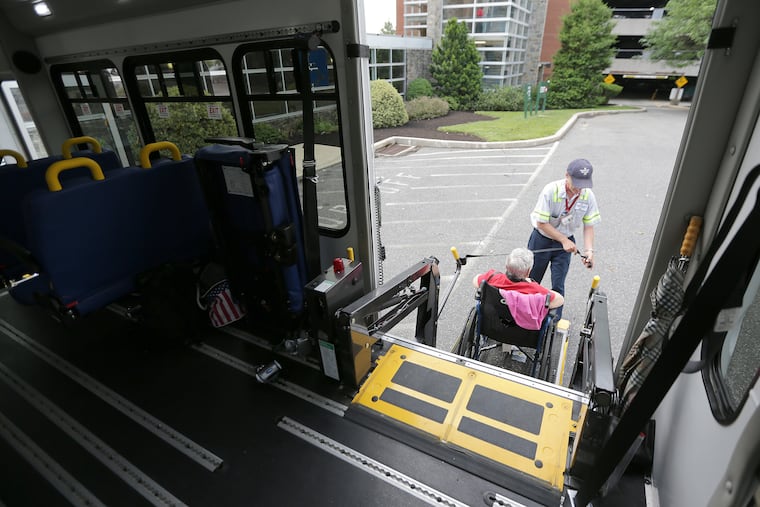Pennsylvania wants to fix its Medicaid transit program, but there’s no easy way to do it, report says
For years, county officials have said changing the way Pennsylvania transports Medicaid patients to doctors’ appointments would be a complicated endeavor. A new report says they’re right.

For years, county officials have said changing the way Pennsylvania transports Medicaid patients to doctors’ appointments would be a complicated endeavor. A new report says they’re right.
Currently, the state allows counties to decide how to transport residents. A proposed alternative would pay independent brokers to coordinate transportation across regions. A state-commissioned report, delivered to state legislators Friday, said both options have disadvantages. It didn’t recommend one approach over the other for overhauling the Medical Assistance Transportation Program, the state’s answer to a federal mandate to offer free nonemergency medical transportation for Pennsylvania’s 2.8 million Medicaid patients.
“A careful review of the advantages and disadvantages of maintaining the in-house county models versus implementing the proposed broker model in Pennsylvania needs to be considered before a change,” the report said.
County officials had called for the study. Brinda Penyak, deputy director of the County Commissioners Association of Pennsylvania, said the report is indicative of the concerns of local officials, who have created systems to fit the unique needs of their residents.
"We have been concerned all along, and the report pointed a lot of that out,” she said. "There are a whole lot of reasons why it was difficult to come up with very distinct recommendations that would be applicable statewide because of the differences from one county to the next.”
Penyak said the report lays the foundation for a more comprehensive approach to addressing the state’s concerns.
A provision tucked into the 2018-19 state budget bill called for an overhaul of the Medical Assistance Transportation Program. Under the amendments to the Human Services Code, the program would become a regional system, with a few companies coordinating transportation across the state. The change would make the state eligible for millions in additional federal funding and quell some concerns over the long-term viability of the current system.
However, county officials and local transit providers asked the state to hold off on changing the system and to study potential unintended consequences, which they said could include worse service for customers and financial losses to the state as costs shift.
County officials and local transit providers said the state’s interconnected shared-ride system saves money and time by splitting the fixed costs of transportation — driver pay, fuel, vehicles — among the Medical Assistance Transportation Program and several other programs to transport different types of patients together. Proponents call it a national model for efficiency, and local officials said messing with it would have ripple effects.
This summer, state lawmakers directed the Departments of Aging, Human Services, and Transportation to study the 35-year-old program, which roughly 55,000 Pennsylvanians use. Friday’s report found that while the state Department of Human Services could save money, county transportation budgets could suffer.
» READ MORE: As changes come to Pa. Medicaid transit program, counties fear bumps in road
Ahead of the publication of the report, the secretaries of the Departments of Aging, Human Services, and Transportation told lawmakers they wanted to continue talks with the County Commissioners Association of Pennsylvania and the Pennsylvania Public Transportation Association over the next year and a half to explore options for change.
During this time, the departments plan to consider expanding county-based collaborations “that we learned about through completion of the analysis," as well as identify areas of the state that could benefit from a brokered model, officials said in a Dec. 13 letter to lawmakers.
“While supportive initially of the intent of [the legislation], the Wolf Administration has gained a deeper understanding of the relationship between [the Medical Assistance Transportation Program] and the existing [human services transportation infrastructure]," the cabinet secretaries wrote. "As a result, we believe that a statewide brokerage model may not be the best solution to meet the needs of the MATP, the broader [human services transportation] system, and Pennsylvanians who use these systems.”
Under a brokered model, the state would pay a set fee per eligible rider to companies that would run regional programs regardless of how many rides were involved. Now, the state reimburses transit companies based on trips provided. Philadelphia has had a broker model since 2005.
» READ MORE: Overhaul of Pa.'s medical transport program on hold after counties raise concerns
Other states have had mixed success with broker models in terms of customer satisfaction and costs, according to an analysis in Friday’s report.
“While county autonomy in administration has advantages, this arrangement also creates challenges in state oversight, accounting, and procurement as requirements for [human services transportation] programs and [the Medical Assistance Transportation Program] differ,” the report said. “These differences can lead to complexity in meeting the requirements of different sets of regulations.”
Converting to a broker system would decrease the number of entities the state has to keep an eye on and allow for more in-depth reviews, the report said.
In continued talks, Penyak of the County Commissioners Association of Pennsylvania said, "we want to make sure whatever we do is coordinated and considers all perspectives: the county perspective, the state’s perspective, but most importantly, the perspective of the people who rely on these services.”